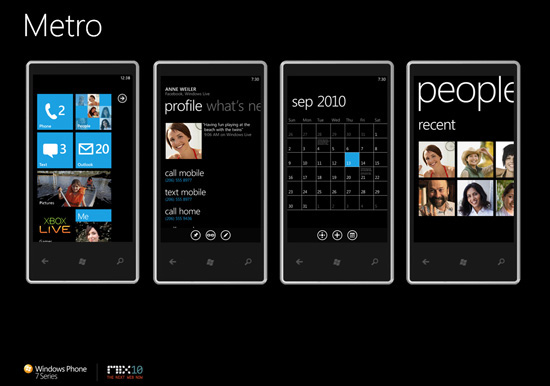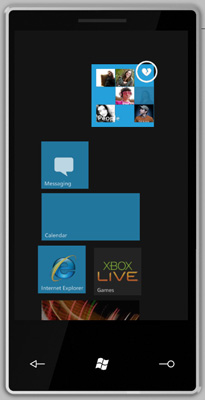Windows Phone 7: The AnandTech Guide
by Brian Klug on March 21, 2010 12:00 AM EST- Posted in
- Smartphones
- Windows Phone 7
- Mobile
Recapitulation
Microsoft MIX 2010 has drawn to a close, and with it comes our concluding wrap-up of everything that there is to discuss about Windows Phone 7 Series (henceforth WP7S).
Let's start at the beginning - WP7S does away completely with everything Windows Mobile. That means Windows Mobile applications won't run on WP7S, hardware running Windows Mobile won't run WP7S (including HTC's HD2), and Windows Mobile is no longer being actively developed. Existing hardware will get support for corporate clients, and the developer tools will remain, but they won't be actively developed. Consider Windows Mobile officially banished from the Microsoft kingdom, and you get the perspective. To give you an example of just how banished Windows Mobile is, there was virtually no discussion of porting applications from Windows Mobile to WP7S - this is a completely different platform. Microsoft wants developers to forget about Windows Mobile and immediately start thinking WP7S. The sense of urgency is because Windows Phone 7 Series will ship before the end of the year ("Holiday 2010").
Microsoft has tossed out the Windows CE-derived, aging UI of Windows Mobile. In its place, it has created a typographically-driven "user experience" that takes taken nods from Windows Media Center, the Xbox Dashboard, Zune HD interface, and urban signage. It calls this style "metro."

Metro - "It's about content and typography"
Instead of standalone application icons, WP7S uses "tiles." In practice, these are almost the same thing, except developers can both change the icon and dominant text to notify the user at-a-glance of status changes or updates. Tiles are supposed to be animated and dynamic. Tiles then launch into sessions and pages. The user interface bleeds off the sides - Microsoft wants people to navigate right to left across a page, teasing the user with elements from neighboring sections. Tiles are rearranged on start page much the same way they are on iPhone OS - pressing and holding levitates a tile, from which point you can either delete the tile (by clicking a broken heart) or drag and rearrange.

Tiles have feelings too...
Optionally, you can launch applications from a comprehensive list view as well.
The UI can be loosely customized, but right now it boils down to four different "accent" colors - which are the tile and UI highlighting colors - and "light" or "dark" for an either black text on white, or white text on black experience. Part of this customization is to leverage the battery-saving properties of AMOLED screens which consume far less power with white text on a black background.
Next are what Microsoft is calling "hubs." These are usually double-wide tiles, and serve as sort of an application for organizing your applications. For example, instead of having a lot of standalone applications which edit or modify photos spread throughout the launcher, you can optionally also launch them through the photo hub right alongside where you view pictures. Another example would be the way apps like Last.fm can themselves be launched from within the music + video hub, right alongside your Zune collection and play history. So far, there are hubs for people, pictures, office, music + video (Zune), marketplace, and games.

Note "apps" to the right. Microsoft is hip.
What each of the hubs do is pretty self explanatory. People is where you'll find all your exchange and local contacts, Pictures is for albums and slideshows, Office includes Excel, Word, and OneNote documents, and Music + Video bundles Zune music and videos alongside other media on WP7S. Marketplace is WP7S' take on an application store, and Games has tight integration with Microsoft's cloud services, including Xbox LIVE. More on that later.
















55 Comments
View All Comments
lifeblood - Sunday, March 21, 2010 - link
" Each time you run the application, WP7S will check that application's signature against the marketplace, both to check that it's valid, and that hasn't been revoked. Yes, marketplace has an application kill-switch."So if I'm out of range of a cell tower and I try to launch a app, it won't run because it can't call home? That's not very helpful, especially if it's a GPS app that I want to use to find my way back home.
erple2 - Sunday, March 21, 2010 - link
I suspect that they'll use a similar route to how the Zune works for its subscription based music. You can still play those songs for a while (a few days?) before having to connect the Zune to a WiFi network.cditty - Sunday, March 21, 2010 - link
I'm sure it will launch the app if it can't make contact. No doubt that they thought of this.at80eighty - Sunday, March 21, 2010 - link
good catch - hope it's not true, because win7 phone had all the trappings of a promising platform & they seem to be castrating it steadily with every press releaseJohnmcl7 - Sunday, March 21, 2010 - link
"There's also the fact that existing SoCs are barely powerful enough to make running a single application feel quick. It won't be until we get multicore Cortex A9 or Intel Moorestown class hardware before we have the horsepower to multitask without a tangible performance impact."
Maybe that's what Microsoft/Apple would like to think but it's clearly not the case at all with several current phones having no problems supporting multitasking without performance issues. There are limits to the number of apps that can be handled simultaneously before it impacts performance but my current phone can easily handle 5 to 6 apps with no impact to the current app in use.
The lack of SD card slot is concerning as it removes an easy way to back up on the move, while it's easy to have plenty of onboard memory it can be a pain in the neck if the device dies as you lose access to it. Of course you can still back up to a PC but with the increasing capabilities of smartphones, they're generally moving away from being connected to the PC.
John
fcx56 - Tuesday, March 23, 2010 - link
Microsoft wants (for better or worse) your information backed up in the cloud. If you re-read the bit about the SMS app it gives a cloud backup error message.darwinosx - Sunday, March 21, 2010 - link
As usual Microsoft interface design is different for no reason other than to be different. They are also too little too late. So the choice remains to either get an iPhone and put up with AT&T or Android. Android is a lame copy of the iPhone with crap hardware and if Apple wins the lawsuit or an injunction then Android becomes an even poorer copy of the iPhone.zinfamous - Sunday, March 21, 2010 - link
come on, reader1/perks! couldn't you just use the same username here as you do in DailyTech? It makes it easier for the rest of us to know the content of your post rather than having to waste our precious 20 seconds reading them, when all it will be is yet another baitish, everything-but-Apple, FUD-ridden marketing ploy.FITCamaro - Sunday, March 21, 2010 - link
So the fact that the Droid shares much of the same hardware as the iPhone and that there are other Android phones with even more powerful hardware than the iPhone makes it crap?at80eighty - Sunday, March 21, 2010 - link
Android is a lame copy of the iPhone with crap hardwarewell alright then - looks like the Brainwash2000 MAChinery did a good job with you